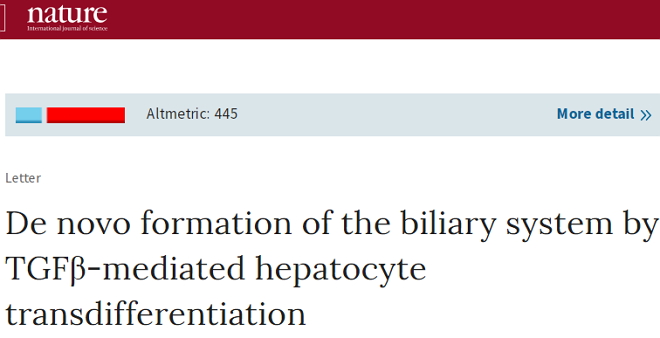Release date: 2018-05-04 Doi:10.1038/s41586-018-0075-5 On March 2nd, an article in the journal Nature entitled "De novo formation of the biliary system by TGFβ-mediated hepatocyte transdifferentiation" showed that when a disease or injury causes a critical loss of liver cells, the liver will indicate another One type of cell "changes identity", replaces the missing, repairs the damage. "Our research shows that the formation and function of hepatocytes is very flexible. This flexibility provides an opportunity to treat liver disease," said Holger Willenbring, a professor of surgery at the University of California, San Francisco (UCSF) Liver Center. They hope to use this as a starting point to find alternative ways to repair tissue damage, eliminating the need to grow organs from scratch by stem cells. What is Alagille syndrome? Alagille syndrome (ALGS) is a rare hereditary disease caused by defects in the Notch pathway (involved in cell development) that cause liver bile duct dysplasia, leading to disorders in the patient's liver. The incidence of this rare disease is about 1 in 30,000. In most cases, the symptoms appear in infants and young children. Under normal circumstances, the liver bile duct is responsible for the delivery of bile, which assists in fat metabolism and treats toxins. Once the bile duct dysplasia causes the bile to fail to circulate properly, it can cause serious damage to the liver. More than 50% of patients with ALGS eventually need a liver transplant. Mic that mimic Alagille syndrome are born without the branches of the biliary tree (A), but show a near-normal appearing biliary system at adult age (B). To build the missing branches, liver cells switch identity and form tubes, shown in Green, that connect to the trunk of the biliary tree, shown in blue (C). The images are part of a study about liver regeneration published in Nature by scientists at Cincinnati Children's and the University of California San Francisco. Credit: Cincinnati Children's New mechanism for rapid liver repair The liver is the largest organ in the digestive system and is responsible for a variety of physiological responses, including metabolism, detoxification, bile secretion, immune defense... like a huge "chemical plant." In the latest research, scientists have found that the ability of the liver to repair quickly does not depend on stem cells. Initially, the research team constructed mutant mice that lacked biliary cells, and like ALGS patients, these mice quickly developed symptoms of liver damage. However, over time, the symptoms of the mice have improved. This phenomenon made the research team very surprised. After in-depth research, they found that hepatocytes can “transform†into bile duct cells at an extremely fast rate and form well-functioning bile duct tissue. New research further suggests that the Notch pathway is a necessary condition for the formation of bile ducts and can be replaced by another pathway once damaged. Moreover, this alternative mechanism is regulated by transforming growth factor-beta (TGF-beta). As early as July 2017, an article published in the journal Nature reported that if the regenerative capacity of hepatocytes is impaired, the biliary cells become hepatocytes. Combined with the latest research, scientists believe that the "identity transformation" of cells is the main auxiliary mechanism for liver damage repair. Image source: Pixabay Five years of discovery “We have known for a long time that the liver has greater regenerative capacity than other organs. With the development of research techniques, we have been able to dig deeper into the mechanisms behind it.†Development of Gastroenterology, Hepatology and Nutrition in Cincinnati Children's Hospital Biologist Stacey Huppert said. From discovering the phenomenon to analyzing the reasons, Stacey Huppert and Holger Willenbring spent five years. The team found that the mouse liver can build the entire biliary system by relying on the "identity change" mechanism. They hope that this research will turn to the clinic as soon as possible. Editor: Leisurely Reference materials: Liver fix thyself—How some liver cells switch identities to build missing plumbing Source: Bio-Exploration Fruit juice drinks is a beverage made of fruit juice products obtained by physical methods such as pressing, centrifugation and extraction. Fruit juice retains most of the nutrients in the fruit, such as vitamins, minerals, sugar and pectin in dietary fiber. Often drinking fruit juice can help digestion, moisten the intestines and supplement the lack of nutrients in the diet. Juice Drinks,Honey Tea,Honey Citron Tea,Goji Berry Juice Xi'an Gawen Biotechnology Co., Ltd , https://www.agolyn-bio.com


There are two kinds of fruit juice: pure fruit juice and compound fruit juice. As far as pure fruit juice is concerned, it can be divided into two types: one is to directly use the original juice, and the other is to dehydrate the freshly squeezed fruit juice first, and then add water to reduce it into concentrated fruit juice. Most pure fruit juices are concentrated. AGOLYN offers various flavors of honey tea, such as honey Citron tea etc.
Change your identity? Nature reveals a new mechanism for liver damage repair